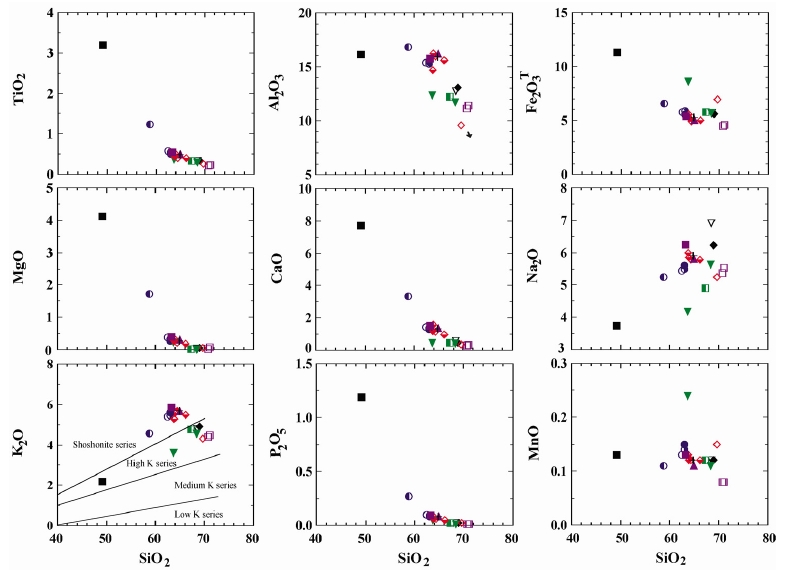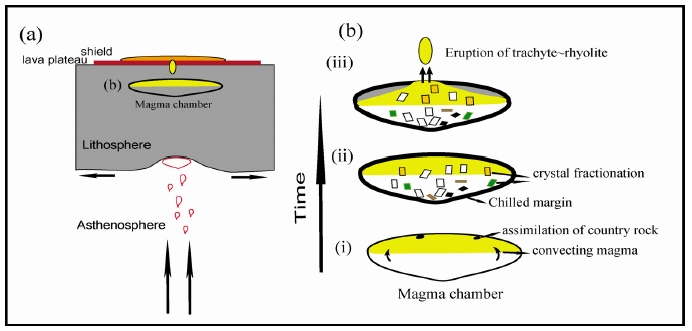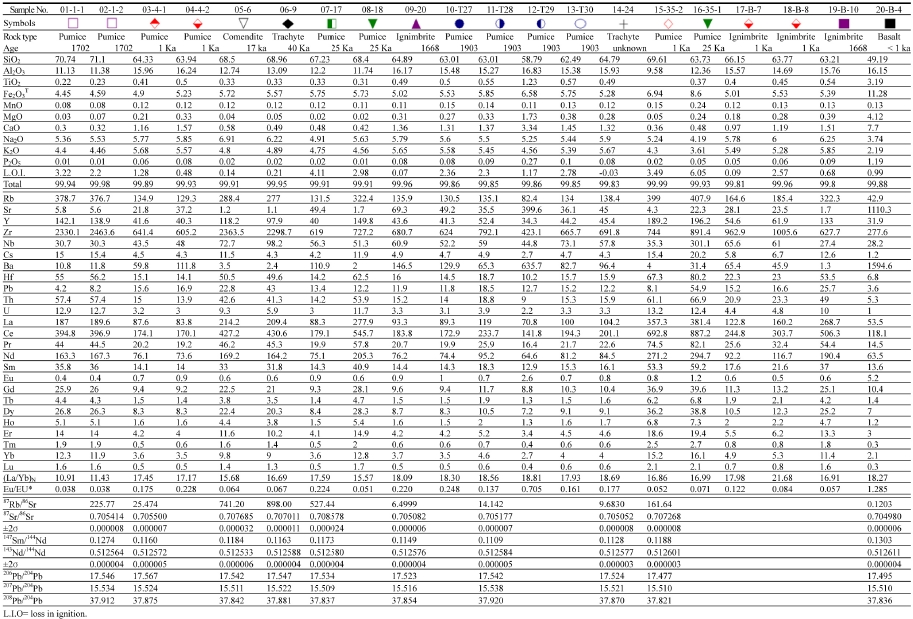
Petrochemical characteristics of volcanic rocks of historic era at Mt. Baekdusan
The genesis and magma evolution were investigated with respect to volcanic rocks erupted for historical era from summit caldera at Mt. Baekdusan volcano, using a comprehensive data set of major and trace elements, Sr, Nd, and Pb isotopic compositions. Based on the geological survey for summit caldera area, historic eruption materials are mainly composed of pumice, and trachyte and alkali rhyolite of the Baekdusan stratovolcano is overlain by this historic pumice. Total alkali content change for an increase of the SiO2 indicates a differentiation tendency of alkali basalt magmas, and corresponds to the high-K-series. REEs pattern normalized to the chrondrite are more enriched in HREEs than LREEs with weak positive Eu anomaly in trachybasalt, but mild to strong negative Eu anomaly from trachyte to rhyolite. It can be divided two group, group-A ( 1 ka Millennium pumice, 1668 and 1905 pumice) and group-B (40 ka trachyte, 17 ka obsidian comendite, 25 ka pumice, 1702 pumice) according to the relative enrichment of HREEs. The geochemical characteristics and modelling result indicated that fractional crystallization of plagioclase, pyroxene, hornblende, and biotite occurred from trachybasalt to trachyte in composition, but fractional crystallization of K-feldspar is more important factor from trachyte to rhyolite. Within magma chamber, the upper part has been to be more mafic and the lower part to be more felsic by the fractional crystallization. The felsic magma eruption with more vapour component took place prior to the mafic magma eruption. Volcanic activity in Mt. Baekdusan summit during historical era was resulted from intraplate magmatism and trace elements do not indicate significant contributions from a subduction slab. Sr, Nd, Pb isotope ratios with same to basalt of the lava plateau indicate that lavas in summit were originated by melting of the same source material without little or no assimilation-contamination of crust material, being similar to source rocks of basaltic rocks in NE China.
초록
백두산 천지 칼데라 정상부에 분포하는 역사시대의 시료를 채집하여 암석화학적 특징을 통해 그 성인과 마그마 진화에 규명하고자 주성분, 미량성분과 Sr, Nd, Pb 동위원소 비에 대한 지화학적 특징을 고찰하였다. 지질조사 결과 백두산 천지 칼데라 정상부 부근의 역사시대 분출물은 대부분 조면암에서 유문암 성분으로 구성된 부석층이며, 이들 하부의 용암류는 성층화산체를 이루는 조면암과 알칼리유문암이다. 운석에 대해 표준화한 REE 패턴을 보면 경희토류원소 함량이 중희토류원소 함량에 비해 부화되어 있는 특징을 가진다. 미량원소와 희토류원소의 부화 정도에 따라 A-그룹(1 ka 밀레니엄 부석, 1668년, 1903년 분화 부석들)과 B-그룹(40 ka 조면암, 17 ka 흑요석질 코멘다이트, 25 ka 부석, 1702년 부석들)으로 구분할 수 있다. 조면현무암에서는 Eu의 정(+) 상관관계를, 조면암에서 유문암까지는 점차 부(-)의 상관관계가 강해진다. 지화학적 모델링 검토를 통한 결과와 지화학적 변화 특징을 고찰해 보면, 조면현무암에서 조면안산암을 거쳐 조면암까지는 사장석, 휘석, 각섬석, 흑운모가 분별결정작용에 큰 영향을 미치는 반면에, 유문암에서는 사장석보다는 K-장석이 큰 영향을 미친 것을 볼 수 있다. 동일한 마그마방내에서 결정분화작용에 의해 상부는 조면유문암질 성분으로, 하부는 조면현무암질 성분으로 점이적으로 나뉘어졌으며, 상부에 있던 유문암질 마그마가 폭발성에 의해 먼저 분출한 후 조면현무암이 분출하였다. 백두산 정상부의 화산활동은 용암대지의 현무암처럼 판내부 화산활동에 의해 형성되었으며, 미량원소 함량 조성은 섭입대에서 유래된 마그마 작용에 연관된 의미있는 증거를 나타내지 않는다. Sr, Nd, Pb 동위원소 비는 일부 시료에서 지각 동화작용을 약간 받은 것을 제외하면, 거의 같은 근원물질에서 기인한 것을 나타낸다. 동아시아에 분포하는 현생대 현무암들과 비교해 보면 결핍된 맨틀과 EM I 사이의 값을 가지는 북동 중국에 분포하는 현무암과 유사한 근원물질에서 유래했음을 지시한다. 이러한 지화학적 특징은 신생대 동안 연약권의 상승에 의한 화산활동의 결과로 해석된다.
Keywords:
Mt. Baekdu, historic era, magma genesis, magma evolution, fractional crystallization, extentional environment, intra-plate magmatism, 백두산, 역사시대, 마그마 성인, 마그마 진화, 분별결정, 신장환경, 판내부 마그마작용1. 서 론
한반도 북부에 위치한 백두산은 과거 1 Ma 이내에 수십 차례의 분화와 역사시대 분화경험을 가진 활동적인 화산으로, 2002년 6월 말 이후 다양한 분화의 전조들이 나타남에 따라 백두산의 미래 분화시점에 대한 관심이 커지고 있다. 동북아시아는 신생대 화산활동이 활발했던 지역으로, 한반도의 백두산, 제주도, 울릉도·독도를 포함하여 일본 본토의 남서부, 북동 중국과 남동 중국에는 알칼리 현무암과 더불어 솔레아이트질 현무암이 함께 수반되어 광범위하게 산재되어 분포한다(Liu et al., 1983; Nohda et al., 1988; Nakamura et al., 1990; Song et al., 1990; Fan and Hooper, 1991; Tatsumoto and Nakamura, 1991; Tatsumoto et al., 1992; Shibata and Nakamura, 1997; Zou et al., 2000; Chen et al., 2001; Hoang and Uto, 2003; Choi et al., 2006). 특히 중국에 분포하는 신생대 현무암질 화산암류들은 해안선을 따라 대체로 NE에서 NNE 방향의 단층선에 연관하여 소규모로 대륙연변부에 광범위하게 분포하고 있다(Shin et al., 2012; Li et al., 2014). 백두산도 이러한 단층계와 연관되어 분포하고 있다.
1970년대 이후로 동북아시아에 분포하고 있는 현무암류들에 대한 연구가 보고되고 있다. 지체구조적 문제와 연관하여 이러한 현무암들의 형성과 성인에 대해 과학자마다 다양한 모델을 제시하고 있다. 유라시아판 아래로의 태평양판의 섭입 혹은 단순한 대륙 확장(extension)과 열림(rifting)의 모델이 제시되고 있다(Zhou and Armstrong, 1982; Liu et al., 1983, 2001; Ye et al., 1987). 백두산의 화산작용이 유라시아판 아래로 섭입한 태평양판의 체류 메가슬랩으로부터 탈수작용에 기인하여 형성된 마그마로부터 유래한다는 연구 결과(Ohtani and Zhao, 2009; Kuritani et al., 2011)가 제시되었으나, Yun et al. (1993), Chen et al. (2007)과 Zou et al. (2008) 등은 백두산 지역 화산암류의 미량원소 지구화학적 특징이 섭입대 화산암류의 특징과 일치하지 아니함에 근거하여 백두산 지역의 마그마가 섭입된 태평양판의 영향을 받지 아니한 것으로 해석하였다. Tang et al. (2014)는 태평양판의 체류 메가슬랩 사이의 공간(gap)을 통하여 그 하부 맨틀로부터 마그마가 상승하여 백두산 지역의 화산암을 형성하는 것으로 보고하였다.
백두산에 대한 역사시대 분화 기록에 대한 연구 자료가 보고되어 왔다(Yun and Cui, 1996; Miyamoto et al., 2010; Yun and Lee, 2011). 특히 Yun (2013)은 기록된 고문헌 연구를 통해 화산활동의 시기와 현상에 대해 자세히 연구한 바 있는데, 백두산의 화산활동은 서기 939년의 분화에서부터 1925년 수증기마그마성 분화까지 지속적으로 분화활동이 일어났던 것으로 보고하였다.
화산폭발지수(VEI) 7의 밀레니엄 초거대분화에 의한 강하부석층은 백두산 부근에서 최대 두께 73 m에 달하며, 칼데라에서 동쪽으로 멀어짐에 따라 삼포 일원에서는 1~30 m, 동해 해저에서는 10 cm 내외, 일본 홋카이도와 혼슈 북부지역에서는 1~5 cm가 남아있으며, 백두산-토마코마이 테프라(B-Tm: Baegdusan- Tomakomai tephra)로 명명되어 1천 년 전에 분화한 화산분출물의 열쇠층으로 사용되고 있다(Machida et al., 1981, 1990; Machida and Arai, 1983; Horn and Schmincke, 2000; Guo et al., 2006; Wei et al., 2013). 강하화산재의 분화에 수반하여 형성된 화쇄류는 천지 주변 약 60 km까지 흘러 부석층 위를 덮거나 계곡에 퇴적되었다. 밀레니엄 분화 이후에도 수차례의 화산분화가 있었음을 역사기록으로 알 수 있다(Yun, 2013). 밀레니엄의 폭발적인 초거대분화 이후에 백두산 화산에서는 간헐적으로 중·소규모의 분화활동이 26회 이상 있었다. 함경도 지역에서 발견된 것들도 있지만, 500 km 이상의 원거리에 폭발적인 분화의 충격파가 전파되었거나 화산재가 비처럼 내리는 강하화산재가 관측된 것은 주로 플리니안 분화가 있었음을 지시한다.
본 연구에서는 백두산 화산의 밀레니엄 대분화 이후에 백두산 화산지대에서 발생한 화산 분화사건으로 추정되는 기록들을 역사 문헌에서 발굴하여 화산학적 해석을 바탕으로 백두산 현지에서 지질조사를 시행하여 천지 칼데라 주변의 역사시대 분화물에 대한 시료를 채취하였다. 연구 시료들은 주로 부석들이며, 천지 주변에서 40 ka부터 역사시대 1668년, 1702년, 1903년 분화를 주 대상으로 하며, 백두산 동쪽 약 10 km 지점의 무두봉 정상에서 밀레니엄 부석을 피복하는 것으로 알려진 조면현무암 1개를 포함하였다. 본 연구는 주성분, 미량성분 및 Sr, Nd, Pb 동위원소비 분석을 통하여 백두산 정상부의 화산활동의 지구화학적 특성과 성인을 알아보고, 한반도 부근에서의 신생대 화산활동의 근원물질과 비교하고자 한다.
2. 백두산 정상부의 지질
백두산 화산 지역은 고근기(Paleogene) 올리고세(28.4 Ma)에 열곡형 단층대를 따라 2회의 간헐적인 현무암 분출로 마안산기 화산활동이 시작되었으며, 초기 마이오세(23-15 Ma)에 증봉산기 현무암이 틈새분화로 분출하였으며, 동시에 틈새분화를 통하여 다량의 현무암(장백기 현무암, 내두산기 현무암 등)이 일류(溢流)되어 광활한 용암대지 즉 개마용암대지를 이루었다(Yun et al., 1993). 플라이오세 말에서 플라이스토세 초기(4.2-0.6 Ma)에 분화 양상이 점차 중심식 분화로 바뀌어 천지를 중심으로 완만한 경사를 이루며 넓고 평탄한 순상화산체를 만들었다(군함산기 현무암 또는 백산기 현무암).
후기 플라이스토세 말(0.6-0.08 Ma)에 규장질 마그마가 대규모로, 여러 번 분화(백두산기 조면암)하여 원추형의 백두산 성층화산체를 형성하였다. 제4기 홀로세에 들어와 성층화산체의 사면에서 몇몇 소규모의 현무암질 화성쇄설구들이 형성되었으며, 홀로세 말기에 강력한 폭발적인 대분화가 발생하여 부석(백운봉기 부석층)을 포함한 다량의 화산재를 뿜어내고 산정부가 함몰되어 직경 약 5 km 내외의 천지칼데라를 형성하였다(Yun et al., 1993). 황색 부석층은 약 26 ka 전 또는 4 ka 전, 그 상부의 회색과 백색 부석층은 1천 년 전(밀레니엄 분화)에 형성된 것으로 알려져 있다. 이들 강하화산부석층(및 화산재)의 분화에 수반하여 형성된 화쇄류는 천지 주변 약 60 km까지 흘러 부석층 위를 덮거나 압록강과 이도백하 상류계곡들에 퇴적되었다(Miyamoto et al., 2010). 천지 칼데라 외륜산 꼭대기에는 이들을 피복하는 역사시대 즉 서기 1668년, 1702년의 분화물이(그림 1), 천지 호반에는 1903년 분화물이 분포하는 것이 최근 지질조사를 통하여 식별되었다(Yun et al., 2013; 그림 2). 백두산 동쪽 약 10 km 지점의 무두봉 꼭대기에는 두꺼운 밀레니엄 부석층을 피복하는 적색의 조면현무암이 관찰된다(Lim, K.M., personal communication, 2009)고 한다.
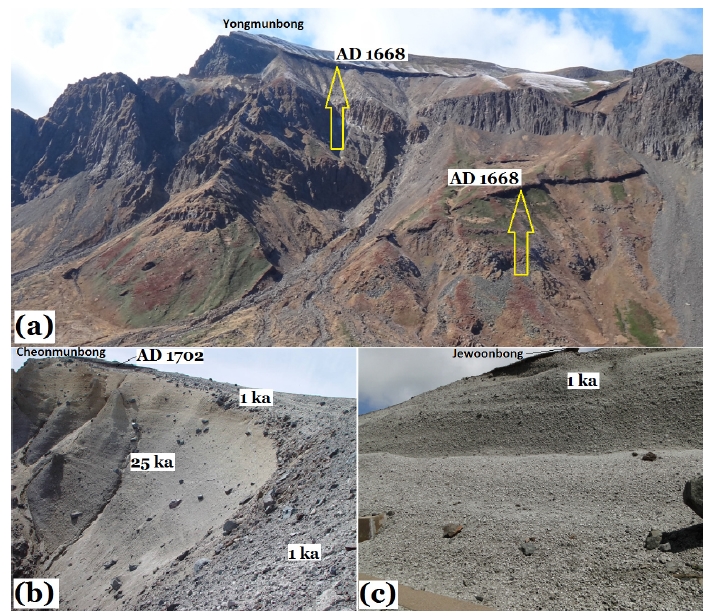
Outcrop of pumice and pyroclastic flow sheet at the summit of Cheonji caldera. (a) Arrow indicates 1668 dark trachytic ignimbrite sheet. (b) 25 ka (Wei and Gill, 2013) grey to yellow pumice, 1 ka Millennium grey pumice, and 1702 dark grey pumice at the Cheonmunbong (Tianwenfeng in Chinese). (c) 1 ka Millennium white~grey pumice deposits near the summit of the southwestern somma. Location of outcrops are shown arrows in Figure 2.
3. 암석화학
3.1 분석방법
본 연구에서는 백두산 정상부에 나타나는 역사기록을 가진 화산암류를 채집하여 분석하였다. 주성분은 부경대학교에서 X-선 형광분석(X-ray fluorescence; XRF) 방법으로 총 20개의 시료를 분석하였다. 미량원소와 희토류원소는 한국기초과학지원연구원에서 고온에서 녹여 만든 용융비드(bead)를 이용하여 유도결합플라즈마 질량분석기(ICP-MS: Inductively Coupled Plasma-Mass Spectrometer)로 분석하였으며 분석과정 및 보정 방법은 Park et al. (2013)에 따라 수행되었다. Nd, Sr 및 Pb동위원소 분석은 한국기초과학지원연구원의 열이온화질량분석기(TIMS; Thermal Ionization Mass Spectrometry, VG 54-30)로 분석하였다. 분석기간 중 Nd와 Sr 분석을 위한 표준시료 NBS987에 대한 평균치는 87Sr/86Sr=0.710257± 0.000004 (N=30), Jndi-1에 대한 143Nd/144Nd=0.512100± 0.000003 (N=20)~0.511833±0.000006 (N=20), Pb에 대한 표준시료 NBS981에 대한 평균치는 206Pb/204Pb= 16.903±0.005, 207Pb/204Pb= 15.448±0.005, 208Pb/204Pb= 36.563±0.015, 207Pb/206Pb= 0.9140±0.0001, 208Pb/206Pb= 2.1631±0.0004 (N=30)이였다.
3.2 주성분
주성분 분석에 대한 결과는 표 1과 같다. MgO는 4.12~0.02 wt.%의 범위를 나타낸다. SiO2에 대한 총알칼리 함량 변화도(그림 3)에서 보면 SiO2가 증가함에 따라 조면현무암에서 조면안산암~조면데사이트까지 총알칼리 함량이 증가하다가, SiO2가 66 wt.% 이상에서는 총알칼리함량이 감소하면서 유문암에 해당하는 변화를 보인다. 이는 이탈리아 판텔레리아(Pantelleria)섬과 에티오피아의 게담사(Gedamsa) 화산체에서 보이는 알칼리현무암에서 조면암까지에서 나타나는 경향과 일치한다(Peccerillo et al., 2003; Ferla and Meli, 2006).

Major- and trace- element abundances and Sr-Nd-Pb isotopic compositions of the historic era volcanic rocks from Mt. Baekdusan summit, Korea.
SiO2에 대한 주성분변화도(그림 4)에서 TiO2, Fe2O3T, MgO, CaO, P2O5는 감소하는 경향을, Na2O, K2O는 증가하는 경향을 보이며 Al2O3은 16.15 wt.%에서 SiO2값이 58.79 wt.%(조면안산암) 시료에서 16.38 wt.%까지 약간 증가하다가 그 이후에는 감소하는 경향을 나타낸다.
SiO2에 대한 K2O값에 의해 본 연구 시료 중에서 덜 분화된 가장 고철질의 시료(SiO2 함량 49.19 wt. %을 가진 No. 20)를 기준으로 했을 때 high K-ser-ise에 해당한다(그림 4).
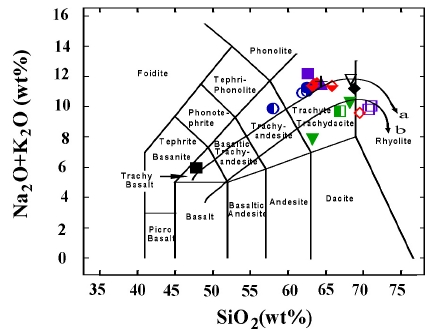
Total alkali (K2O+Na2O) vs. SiO2 diagram for historic era volcanic rocks from Mt. Baekdusan summit (Le Bas et al., 1986). The arrow a and b are the composition variation from basalt to rhyolite of the alkaline suites in Pantelleria Island, Italy (Ferla and Meli, 2006) and Gedamsa volcano, Ethiopia (Peccerillo et al., 2003), respectively. Symbols as in Table 1.
3.3 미량성분
SiO2에 대한 미량성분변화도(그림 5)에서 SiO2가 증가함에 따라 Rb, Hf, U, Y, Zr은 증가하는 경향을, Ba, Sr은 급격히 감소하는 경향을 보여준다. Pb는 전체적으로 증가하는 경향을 가지나 연구시료 중에서 가장 진화된 규장질 성분을 나타내는 유문암(No, 1, 2 & 15)에서 오히려 감소한다. 전체적으로 레일리 분별결정작용(Rayleigh fractionation)의 모델링의 경향을 보이나(Ferla and Meli, 2006), 조면현무암을 제외한 분화된 시료의 미량성분에서 성분상의 갭(gab)이 나타나므로 그룹 A와 B로 나누어 그 특징을 구분하여 고찰하고자 한다. 그룹 A에 속하는 시료는 1 ka 밀레니엄 부석, 1668년, 1903년 분화 부석들이며, 그룹 B에 속하는 시료는 40 ka 조면암, 17 ka 흑요석질 코멘다이트, 25 ka 부석, 1702년 부석으로, 그룹 A에서 그룹 B로 감에 따라 Rb, Hf, Th, U, Y이 성분상 갭을 가지고 증가하는 경향이 나타난다.
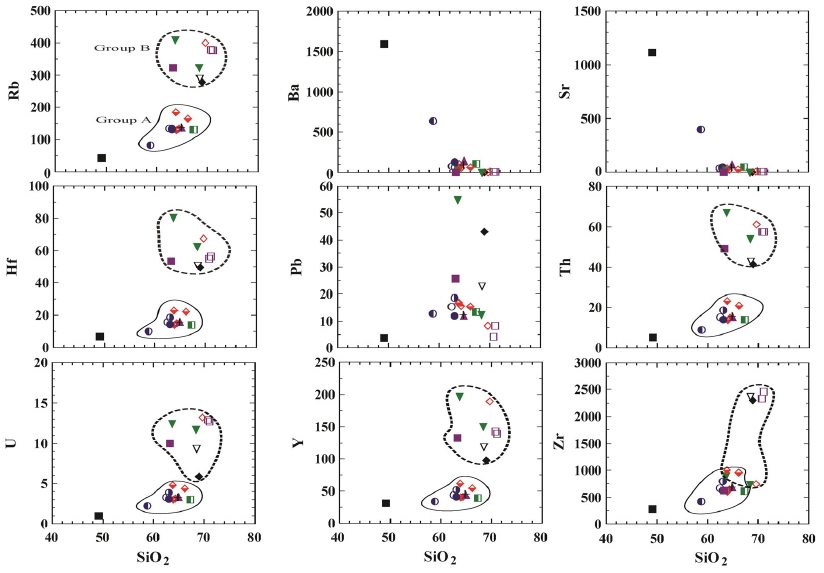
Trace elements vs. SiO2 variation diagrams for historic era volcanic rocks from Mt. Baekdusan summit. Symbols as in Table 1.
운석에 대해 표준화해 보면(그림 6), 덜 분화된 가장 고철질의 시료(SiO2 함량 49.2 wt.%을 가진 No. 20)의 패턴은 LREEs가 HREEs에 비해 부화되어 있으며 Eu의 정(+) 이상의 관계를 나타낸다(Eu/Eu*=1.3 (표 1; 그림 6a). 다소 분화된 시료들도 LREEs가 HREEs에 비해 부화되어 있으나, 조면암산암(시료 No. 12)에서는 약한 Eu의 부(-) 이상(Eu/ Eu*=0.7)을 나타내며 유문암에서 조면암의 시료들은 강한 Eu의 부 이상을 나타낸다(Eu/Eu*=0.04~0.2). 조면암에서 유문암에 해당하는 시료들은 앞에서 언급된 바와 같이 크게 두 그룹으로 구분해 살펴볼 수 있으며 전체적으로 그룹 B가 그룹 A에 비해 Eu를 제외하고 REEs이 부화되어 있으며, (La/Yb)N 값은 그룹 A에서는 15.6~21.7, 그룹 B에서는 10.9~16.9로 그룹 A에서 그룹 B로 감에 따라 다소 감소한 값을 나타낸다. Sr 함량의 급격한 감소에서 볼 수 있듯이(그림 5) 사장석의 분별작용이 분화가 됨에 따라 강하게 일어났으며, 운석에 표준화한 값으로 비료해 볼 때 LREEs보다 HREEs에 더 호정성이 있는 그룹 B에서는 감람석, 휘석, 각섬석과 같은 유색광물의 분별결정작용에 기인하여 HREEs 값이 다소 낮아진 것으로 사료된다.
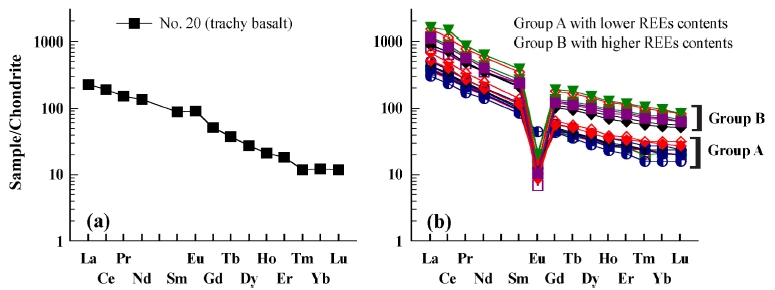
Chondrite-normalized REE patterns of historic era volcanic rocks from Mt. Baekdusan summit. Normalization values after Sun and McDonough (1989). (a) The positive Eu anomaly in sample 20 (trachybasalt) may be related that the fractionation of plagioclase has not occurred in the early stage. (b) The normalized REE pattern is divided into two, that is, the abundances is more rich in group B and more depleted in group A. Symbols as in Table 1.
멜트에 대한 불호정성 순서대로 원시맨틀에 대해 표준화하여 나열해 보면(그림 7), 가장 덜 분화된 조면현무암(그림 7a)은 해양도현무암(OIB)과 유사하나 미약한 Nb 부의 이상을 나타내며, 더불어 판의 섭입환경에서 일반적으로 나타나는 Pb의 경향과 다른 부의 이상을 보여주고 있다. 조면암에서 유문암까지 강한 Pb의 정의 이상을 보여주며 전반적으로 원소들의 함량이 증가함을 보여준다(그림 7b, 7c). 가장 덜 분화된 조면현무암에 대한 자료를 중심으로 Zr/Y에 대한 Zr 성분(그림 8)으로 검토해 보면, 중국 동북쪽에 분포하는 현생 현무암류와 비슷한 지화학적 특징을 나타내며 판내부 현무암의 영역에 도시됨을 알 수 있다. 또한 백두산의 신생대 현무암의 경우에도 동일하게 판내부 현무암의 영역에 도시됨을 알 수 있다.

Primitive-mantle (PM) normalized spider diagrams for historic era volcanic rocks from Mt. Baekdusan summit. Elements are arranged in the order of decreasing incompatibility from left to right. The values of primitive mantle and oceanic island basalt (OIB) (in ppm) are from Sun and McDonough (1989). Symbols as in Table 1.
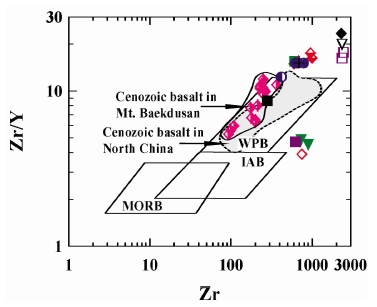
Zr-Zr/Y diagram for historic era volcanic rocks from Mt. Baekdusan summit (after Pearce and Norry, 1979). Data of Cenozoic basaltic rocks in Mt. Baekdusan is from Kuritani et al. (2009). Data of Cenozoic basaltic rocks in North China is from Liu et al. (1983). More mafic sample 17 is plotted within the WPB field. Symbols as in Table 1.
3.4 동위원소 지화학적 특징
87Sr/86Sr은 조면현무암에서는 0.7050이며, 그룹 A에 속하는 시료는 4개의 시료가 0.7051~0.7055, 1개의 시료가 다소 높은 0.7086을 나타내며, 그룹 B에서는 1개의 시료가 0.7054이며 3개의 시료가 다소 높은 0.7070~0.7077 범위를 나타낸다(표 1). 143Nd/144Nd은 조면현무암에서는 0.5126, 그룹 A와 B의 차이없이 0.5125~0.5126의 범위를 나타낸다. 206Pb/204Pb, 207Pb/204Pb, 208Pb/204Pb의 비는 17.49~17.56, 15.51~ 15.54, 37.82~37.92까지의 범위로 유사한 범위를 나타낸다.
전체적으로 그룹 A와 그룹 B의 시료는 Sr과 Nd, Pb 동위원소비가 조면현무암의 값과 유사한 범위를 나타내나 일부 분화된 시료가 높은 Sr 동위원소비를 나타내는 것은 지각물질의 부분적인 동화·혼염작용을 고려할 수 있으나 전체적으로 동일한 근원물질에서 유래했음을 지시한다고 할 수 있다. 이 부분에 대해서는 논의 부분에서 검토하고자 한다.
본 연구 지역의 시료를 한국을 포함한 동아시아 지역의 신생대 현무암질 암석과 특히 백두산의 정상부에서 역사시대에 분출했던 마그마의 근원물질을 고찰하기 위해서 K-Ar 연대로 약 20.6~0.5 Ma에 형성된 백두산 현무암질 순상단계(basaltic shield stage)에서 만들어진 용암대지로부터의 시료와 비교하여 Sr과 Nd 동위원소비를 검토해 보았다(그림 9). 울릉도·독도, 큐슈지역 그리고 백두산 용암대지 시료들은 동위원소적으로 부화되어 있으며, 특히 본 연구 지역인 백두산 정상부의 화산암류의 시료들은 백두산 용암대지의 시료들과 동일한 범위의 값을 나타낸다.
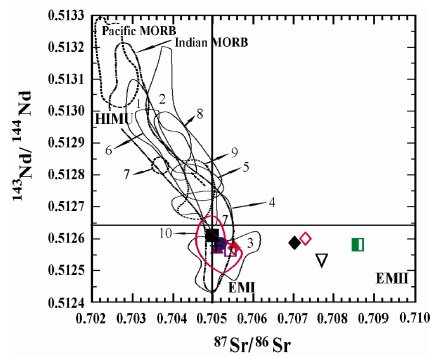
Plots of 87Sr/86Sr (a) and 143Nd/144Nd vs. 87Sr/86Sr isotopic variation diagram for the historic era volcanic rocks from Mt. Baekdusan summit. The approximate fields for HIUM, EM I, EMII are from Armienti and Gasperini (2007). MORB in the East Pacific Rise and MORM in India is from White et al. (1987), Mahoney et al. (1989) and Chauvel and Blichert (2001), The field (1), (2), and (3) are for Cenozoic alkali basalt in NE Japan, Japan basin, and Uleungdo-Dokdo Island, respectively (Iwamori, 1992; Tatsumoto and Nakamura, 1991; Nakamura et al., 1990). The field (4) is for Cenozoic alkali basalt in Northern Kyushu (Nakamura et al., 1990; Hoang and Uto, 2003). The field (5) is for Cenozoic alkali basalt in Jejudo Island (Park et al., 2005; Choi et al., 2006). The field (6) and (7) are for Cenozoic alkali and tholeiitic basalt in SE China, and the field (8) and (9) of Cenozoic alkali and tholeiitic basalt in NE China, respectively (Zhi et al., 1990; Song et al., 1990; Tatsumoto et al., 1992; Liu et al., 1994; Zou et al., 2000; Chen et al., 2001). (10) of Cenozoic basaltic rocks in Mt. Baekdusan (Kuritani et al., 2009). Symbols as in Table 1.
Pb 동위원소비를 비교해 보면(그림 10), 중국 북동부 알칼리와 솔레아이트 현무암류들(영역 8과 9)은 다른 지역의 현무암류들에 비해 낮은 207Pb/204Pb, 208Pb/204Pb, 206Pb/204Pb 비를 가지며 맨틀 단성분으로 나눌 때 DMM과 EM1 사이에 도시된다. 이러한 맨틀의 불균질한 성질에 대해서는 각 단성분 맨틀 성분사이의 섞임으로 해석하고 있다(Park et al., 2005; Choi et al., 2006).
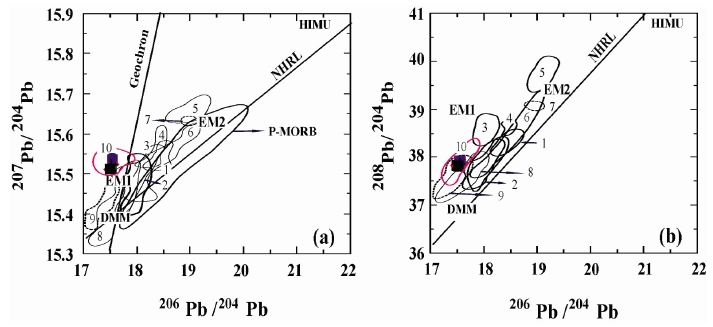
Plots of 207Pb/204Pb (a) and 208Pb/204Pb (b) vs. 206Pb/204Pb for the historic era volcanic rocks from Mt. Baekdusan area. The approximate fields for DMM is from Salters and Stracke (2004). Northern Hemisphere Reference Line (NHRL) is from Hart (1984) and the 4.55 Ga-geochron are from Zindler and Hart (1986). The field abbreviations from 1 to 10 are the same as those in Figure 9 and symbols as in Table 1.
연구 지역의 화산암류들은 백두산 용암대지의 시료가 가지는 Pb 동위원소 비의 범위 내에서 동일한 값을 나타낸다. 앞에서 검토한 바와 같이 연구지역에서 지각물질의 동화․혼염받은 일부 시료를 제외하고 Sr-Nd 동위원소비와 마찬가지로 Pb 동위원소비도 동일하므로 같은 근원물질로부터 기인한 것으로 추정할 수 있다. 백두산에서 용암대지를 이루는 현무암 시료들과 역사시대에 정상부에서 분출된 화산암류들은 크게 북동 중국의 현무암류들과 유사한 맨틀에서 기인한다고 할 수 있다. 그러나 Sr-Nd 동위원소 비에서 다소 부화되어 있으며, 동일한 206Pb/204Pb에 비교했을 때 207Pb/204Pb와 208Pb/204Pb 비가 부화되어 있는 특징을 가지고 있다.
4. 논 의
4.1 모델링을 통한 지화학적 분화 규명
조면현무암에서 유문암까지의 지화학적 변화 특징에 대한 원인을 알아보기 위해 모델링하기 전에 우선 지각혼염의 여부를 알아보기 위해 87Sr/86Sr 에 대한 SiO2 성분도에 도시해 보았다(그림 11a). 연구지역의 시료 중 가장 덜 분화된 조면현무암(No. 20)은 백두산 용암대지로부터의 현무암 시료들과 동일한 Sr-Nd 동위원소 비를 가진다. 좁은 범위로 규정했을 때, 조면현무암에서 조면암~유문암으로 SiO2성분이 증가함에 따라 Sr 동위원소는 그룹 A와 B의 일부 시료에서 약간 증가하여 AFC의 분화경향을 받은 것으로 볼 수 있으나, 넓은 범위에서 비교했을 때(그림 11b), 지각의 혼염 작용은 거의 무시할 정도이다.
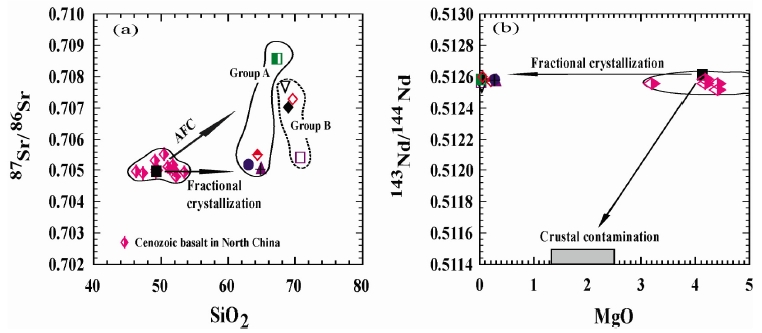
(a) 87Sr/86Sr vs. SiO2 and (b) 143Nd/144Nd vs. MgO diagram of the historic era volcanic rocks from Mt. Baekdusan summit. Note that two different trends, fractional crystallization (FC) and assimilation with fractional crystallization (AFC), are shown in the narrow isotopic range (a) but FC mainly control the geochemistry variation in the wide isotopic range, meaning the crystal contamination effect is minor. Symbols as in Table 1 and Figure 8.
따라서 조면현무암에서 유문암까지 백두산 정상에 분포하는 역사시대의 분출물의 분화과정을 모델링을 통해 검토하고자 한다. 모델링에 필요한 광물/멜트 계수는 멜트의 성분과 압력 등에 따라 다양하지만, 본 연구에서는 특히 유문암의 진화된 지화학적 특징을 검토하기 위해 Pearce and Norry (1979)의 단사휘석, 각섬석의 광물/멜트 계수와 Nash and Crecraft (1985)의 흑운모, 사장석, K-장석 광물/멜트 계수를 사용하여 모델링을 하였다(그림 11). Rb/ Sr에 대한 Sr 성분도(그림 12a)에서 조면현무암(시료 No. 20)에서 조면안산암까지 연장선상에 그룹 A의 조면암이 도시되나, 그룹 B의 조면암은 다소 기울기가 낮은 선상에 도시된다. Rb에 대한 Sr의 성분도(그림 12b)에서 Sr이 감소함에 따라 Rb 함량은 조면현무암에서 그룹 A까지 증가하다가, 그룹 B에서 오히려 감소한다. 이러한 지화학적 경향을 모델링한 결과와 비교해 보면 초기에는 휘석, 각섬석과 사장석이 우세한 분별결정작용이 조면현무암에서 그룹 A의 조면암까지 일어났으며, 그룹 A에서 그룹 B의 유문암으로 분화에는 사장석보다 K-장석의 분별작용이 더 우세하게 나타났음을 지시한다고 할 수 있다.
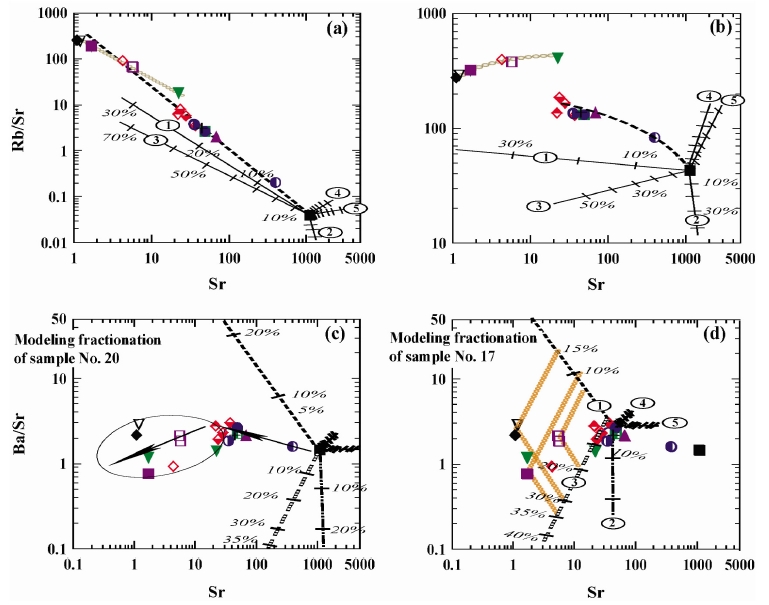
(a) Rb/Sr vs. Sr, (b) Rb vs. Sr, and (c) & (d) Ba/Sr vs. Sr diagrams showing that fractionation of plagioclase, pyroxene, amphibole, biotite plays an important role from the early to middle stage of differentiation (from sample 19 to group A), whereas in the later stage (from A to group B), K-feldspar appears to have controlled the variation of the elements. Partition coefficients of Rb, Sr and Ba are from Pearce and Norry (1979), Nash and Crecraft (1985). Modelling trends of fractional crystallization are: ① =plagioclase; ②=biotite; ③=K-feldspar; ④=pyroxene; ⑤=amphibole. Symbols as in Table 1.
Ba/Sr에 대한 Sr의 성분도(그림 12c)에서도 비슷한 경향이 나타나는데, Sr이 감소함에 따라 조면현무암에서 그룹 A의 조면암까지 약간 증가하다가 그룹 A에서 그룹 B의 조면암으로 감에 따라 산만하지만 전체적으로 감소하는 경향을 보인다. 조면현무암에서 그룹 A의 조면암까지 사장석에 대한 분별결정작용의 모델링 Rb/Sr 비의 결과보다 낮은 이유로는 K-장석과 흑운모의 분별결정을 무시할 수 없지만, 그룹 B까지의 분화는 K-장석의 분별결정작용이 훨씬 우세하게 일어났음을 지시한다고 할 수 있다. 이러한 결과를 그룹 B 중 시료 No. 17을 기준으로 모델링한 결과(그림 12d), 사장석과 K-장석의 다양한 분별결정정도에 따른 결과로 추정할 수 있으며 K-장석이 더 많이 분별결정 되었음을 추정할 수 있다.
주성분 원소와 미량성분 원소의 함량 및 거동에서 백두산 지역의 역사시대 화산암류들이 태평양판(해양판)의 섭입에 연관된 어떠한 지구화학적인 유사성도 나타내지 아니함을 알 수 있으며, 즉 섭입된 태평양판의 체류 메가슬랩으로부터의 탈수작용에 근거한 마그마작용으로 백두산 화산암류가 생성되었을 가능성을 제시한 지구물리학적 검토는 화산암류의 지구화학적 특성과 부합되지 아니하는 것이다. 아울러 Zhao et al. (2009)의 그림 7(b)와 Kuritani et al. (2011)의 그림 2b에서 제시한 백두산 천지를 남북으로 절단하는 단면의 지하 500~600 km 심부에서 심발지진이 발생하고 있는 것처럼 도식한 것은 심각한 오류임을 첨언한다. 이들 심발지진은 백두산으로부터 동쪽으로 220 km 이상 떨어진 두만강 하류 지역과 그 북쪽의 중국과 러시아 국경 부근에서 발생한 것이다.
4.2 역사시대를 통한 백두산 화산활동 규명
백두산 용암대지의 현무암과 성층화산체 칼데라의 정상부에 분출한 조면현무암은 동일한 Sr-Nd, Pb 동위원소비를 가지는 지화학적 특징으로부터 이들이 같은 근원물질에 기인했음을 밝혔다. 지화학적 검토(그림 11)와 모델링의 결과(그림 12)로 부터 부분적으로 일부 시료에서 지각 물질의 혼염·동화작용을 받았지만, 조면현무암에서 조면암을 거쳐 유문암까지 단사휘석, 각섬석, 흑운모, 사장석과 최후에 우세하게 진행된 K-장석의 분별결정 작용에 의해 일련의 분화작용이 진행되었음을 알 수 있었다.
그러나 앞에서 언급한 바와 같이 백두산 성층화산체 동편의 산사면의 무두봉 정상부에 나타나는 조면현무암(No. 20)은 조면암과 유문암 시료보다도 층서적으로 더 후기에 분출되어 밀레니엄 부석층을 덮고 있음을 주지할 필요가 있다. 이는 마그마방에서 결정분화작용이 진행되는 동안 혹은 된 후에 유문암과 조면암이 조면현무암보다 먼저 분출하고 나중에 마그마방 아래 부분에 있던 조면현무암이 소규모로 분출했던 것으로 추정할 수 있다.
연약권 맨틀의 상승(upwelling)에 의해 신장된 환경 하에서 연약권 내 혹은 상부맨틀의 근원물질이 녹아서 형성된 것으로 해석하고 있다(그림 13a). 이러한 연약권 맨틀 상승에 의한 백두산 하부에서 역사시대 동안 마그마방에서 일어난 조면현무암과 유문암까지 지화학적 변화를 도식화하여 단계별로 고찰해 보면(그림 13b), (i) 주변 모암들에 의해 거의 무시할 정도의 혼염작용을 받고, (ii) 마그마방의 외곽부가 점차 냉각되어 가면서 사장석, 단사휘석, 각섬석, 흑운모의 분별결정작용이 일어나고, (iii) 계속적인 K-장석이 우세한 분별결정 작용으로 상부에 조면암질 내지 유문암질 마그마가 형성되었고 휘발성 성분의 농집에 의한 폭발로 마그마방 하부의 조면현무암보다 먼저 분출한 것으로 생각할 수 있다. 이후 마그마방의 하부에 있던 조면현무암이 소규모로 분출하여 이들을 덮은 것으로 보인다.
5. 결 론
신생대에서 시작한 백두산의 화산활동에 대한 역사시대의 기록은 매우 상세하다. 이러한 기록과 더불어 암석의 지화학적 특징 규명은 동아시아에서 일어난 신생대 화산활동을 규명하는데 유용한 정보를 제공한다고 할 수 있다.
본 연구에서는 백두산 정상부에 분출한 암석 시료에 대해 역사적 기록과 지질층서에 따른 체계적인 시료 채집을 통한 지화학적 특징을 고찰하여 마그마의 형성과 그 진화에 대해 알아본 결과는 다음과 같다.
1) 정상부에 나타나는 암석은 주로 알칼리계열의 조면암, 유문암 성분이 분출되어 있으며, 백두산 동쪽 약 10 km 지점의 무두봉 상부에는 밀레니엄 부석층을 피복하면서 그 상부에 조면현무암이 분출하여 있다.
2) 분석된 시료들은 SiO2가 증가함에 따라 TiO2, Fe2O3T, MgO, CaO, P2O5는 감소하는 경향을, Na2O는 증가하는 경향을 나타낸다. Al2O3는 조면현무암에서 조면안산암까지 약간 증가하다가 조면암과 유문암에서는 감소하는 경향을, K2O는 증가하다가 유문암 성분에서 감소하는 경향을 나타낸다.
3) 미량원소와 희토류원소 성분은 조면현무암을 제외하고 SiO2가 증가함에 따라 함량의 갭에 의해 두 그룹으로 나누어 고찰할 수 있으며 그룹 A (1 ka 밀레니엄 부석, 1668년, 1903년 분화 부석들)에서 그룹 B (40 ka 조면암, 17 ka 흑요석질 코멘다이트, 25 ka 부석, 1702년 부석들)로 감에 따라 Rb, Hf, Th, U, Y, Zr이 증가하며 희토류 함량도 증가함을 보여준다. 전제적으로 Ba, Sr 함량은 유문암과 조면암에서 급격한 감소를 나타낸다.
4) 주성분과 미량원소 성분의 지화학적 특징은 마그마의 형성과정에서, 함수유체가 직접적으로 기여하는 해양판의 섭입과는 무관한, 판내부 화산활동에 의해 형성되었으며, Sr, Nd, Pb 동위원소 분석비는 조면현무암과 그룹 A와 그룹 B에서 일부 시료들의 지각의 미약한 동화・혼염작용을 제외하면 거의 유사한 값을 가진다. 이러한 결과는 동일 근원물질로부터 기원한 마그마로부터 형성되었음을 지시한다.
5) 지화학적 모델링을 통한 검토 결과, 마그마방에서 초기에는 사장석, 휘석, 각섬석, 흑운모 등의 분별결정작용이 우세하다가 최후에는 K-장석이 사장석보다 분별결정작용에 더 참여하여 유문암을 형성한 것으로 보인다. 이들은 마그마방에서 분별결정작용이 일어나 상부에는 조면암질~유문암질 마그마가 하부에는 광물의 집적에 의해 조면현무암질 마그마로 성분누대로 나뉘어진 것으로 생각된다. 상부에 있던 조면암질~유문암질 마그마가 휘발성 성분의 농집에 의한 폭발력으로 먼저 분출하였으며 이후에 국지적으로 소규모로 조면현무암이 분출하였다고 사료된다.
Acknowledgments
본 논문을 읽고 건설적인 비평과 조언을 통하여 문장을 개선해 주신 이문원, 박준범 심사위원과 길영우 편집위원과 기원서 편집위원장과 위은정 사무차장, 이정현 연구교수에게 감사드린다. 백두산 동쪽 무명천 계곡 화쇄류 시료와 무두봉 조면현무암 시료와 지질설명내용을 전해주신 故 林權黙 선생과 백두산 일원의 지질 조사를 허락해 준 중국 CEA의 Dr. Haiquan Wei에게 깊이 감사드린다. 본 연구는 소방방재청의 백두산화산대응기술개발사업인 '화산재해 피해예측 기술개발‘ [과제번호: NEMA-백두산-2012-1-2] 과제의 지원으로 이루어 졌습니다. 이에 감사드립니다.
References
-
Armienti, P., and Gasperini, D., (2007), Do we really need mantle components to define mantle composition?, Journal of Petology, 48, p693-709.
[https://doi.org/10.1093/petrology/egl078]

-
Chauvel, C., and Blichert-Toft, J., (2001), A hafnium isotope and trace element perspective on melting of the depleted mantle, Earth and Planetary Science Letters, 190, p137-151.
[https://doi.org/10.1016/S0012-821X(01)00379-X]

-
Chen, S.H., O’Reilly, S.Y., Zhou, X., Griffin, W.L., Zhang, G., Sun, M., Feng, J., Zhang, M., (2001), Thermal and petrological structure of the lithosphere beneath Hannuoba, Sino-Korean Craton, China: Evidence from xenoliths, Lithos, 56, p267-301.
[https://doi.org/10.1016/S0012-821X(01)00379-X]

-
Chen, Y., Zhang, Y., Graham, D., Su, S., and Deng, J., (2007), Geochemistry of Cenozoic basalts and mantle xenoliths in northeast China, Lithos, 96, p108-126.
[https://doi.org/10.1016/j.lithos.2006.09.015]

-
Choi, S.-H., Mukasa, S.B., Kwon, S.-T., and Andronikov, A.V., (2006), Sr, Nd, Pb and Hf isotopic compositions of late Cenozoic alkali basalts in South Korea: Evidence for mixing between the two dominant asthenospheric mantle domains beneath East Asia, Chemical Geology, 232, p134-151.
[https://doi.org/10.1016/j.chemgeo.2006.02.014]

-
Fan, Q., and Hooper, P.R., (1991), The Cenozoic basaltic rocks of eastern China; petrology and chemical composition, Journal of Petrology, 1991, 32, p765-810.
[https://doi.org/10.1093/petrology/32.4.765]

- Ferla, P., and Meli, C., (2006), Evidence of magma mixing in the “Daly Gap” of alkaline suites: a case study from the enclaves of Pantelleria (Italy), Journal of Petrology, 47, p1467-1507.
-
Guo, Z., Liu., J., Han, J., He, H., Dai, G., and You, H., (2006), Effect of gas emissions from Tianchi volcano (NE China) on environment and its potential volcanic hazards, Science in China, Series D, 49, p304-310.
[https://doi.org/10.1007/s11430-006-0304-x]

-
Hart, S.R., (1984), A large-scale isotope anomaly in the Southern Hemisphere mantle, Nature, 309, p753-757.
[https://doi.org/10.1038/309753a0]

-
Hoang, N., and Uto, K., (2003), Geochemistry of Cenozoic basalts in the Fukuoka district (northern Kyushu, Japan): implications for asthenosphere and lithospheric mantle interaction, Chemical Geology, 198, p249-268.
[https://doi.org/10.1016/S0009-2541(03)00031-7]

-
Horn, S., and Schmincke, H.-U., (2000), Volatile emission during the eruption of Baitoushan Volcano (China/North Korea) ca. 969 AD, Bulletin of Volcanology, 61, p537-555.
[https://doi.org/10.1007/s004450050004]

-
Iwamori, H., (1992), Degree of melting and source composition of Cenozoic basalts in southwest Japan: evidence for mantle upwelling by flux melting, Journal of Geophysical Research, 97, p10983-10995.
[https://doi.org/10.1029/92JB00737]

-
Kuritani, T., Kimura, J., Miyamoto, T., Wei, H., and Shimano, T., (2009), Intraplate magmatism related to deceleration of upwelling asthenospheric mantle: Implications from the Changbaishan shield basalts, northeast China. Lithos, 112, p247-258.
[https://doi.org/10.1016/j.lithos.2009.02.007]

-
Kuritani, T., Ohtani, E., and Kimura, J.-I., (2011), Intensive hydration of the mantle transition zone beneath China caused by ancient slab stagnation, Nature Geoscience Letters.
[https://doi.org/10.1038/ngeo1250]

- Le Bas, M.J., Le Maitre, R.W., Streckeisen, A., and Zanettin, B., (1986), A chemical classification of volcanic rocks based on the total alkalis-silica diagram, Journal of Petrology, 27, p745-750.
-
Lei, J., and Zhao, D., (2005), P-wave tomography and origin of the Changbai intraplate volcano in Northeast Asia, Tectonophysics, 397, p281-295.
[https://doi.org/10.1016/j.tecto.2004.12.009]

-
Li, H.-Y., Huang, X.-L., and Guo, H., (2014), Geochemistry of Cenozoic basalts from the Bohai Bay Basin: Implications for a heterogeneous mantle source and lithospheric evolution beneath the eastern North China Craton, Lithos, p196-197, 54-66.
[https://doi.org/10.1016/j.lithos.2014.02.026]

- Liu, R., Sun, J., and Chen, W., (1983), Cenozoic basalts in North China their distribution, geochemical characteristics and tectonic implications, Geochemistry, 2, p17-33.
- Liu, J., Han, J., and Fyfe, W., (2001), Cenozoic episodic volcanism and continental rifting in northeast China and possible link to Japan Sea development as revealed from K–Ar geochronology, Tectonophysics, 339, p385-401.
-
Liu, C.Q., Masuda, A., and Xie, G.H., (1994), Major- and trace-element compositions of Cenozoic basalts in eastern China: Petrogenesis and mantle source, Chemical Geology 114, p19-42.
[https://doi.org/10.1016/0009-2541(94)90039-6]

-
Machida, H., and Arai, F., (1983), Extensive ash falls in and around the Sea of Japan from large late Quaternary eruptions, Journal of Volcanology and Geothermal Research, 18, p151-164.
[https://doi.org/10.1016/0377-0273(83)90007-0]

- Machida, H., Arai, F., and Moriwaki, H., (1981), Two Korean tephras, Holocene markers in the Sea of Japan and the Japanese Islands, Kagaku, 51, p562-569, (in Japanese).
- Machida, H., Moriwaki, H., and Zhao, D.C., (1990), The recent major eruption of Changbai Volcano and its environmental effects, Geographical Reports of Tokyo Metropolitan University, 25, p1-20.
-
Mahoney, J.J., Natland, J.H., White, W.M., Poreda, R., Bloomer, S.H., Fisher, R.L., and Baxter, A.N., (1989), Isotopic and geochemical provinces of the western Indian Ocean spreading, Journal of Geophysical Research, 94, p4033-4052.
[https://doi.org/10.1029/JB094iB04p04033]

- Miyamoto, T., Kanno, H., Okuno, M., Nasu, H., and Makohonienko, M., (2010), Reconstruction of volcanic activities occurring in Baitoushan volcano after 10th century huge eruption, In: Taniguchi, H. (Eds.), Earth Science of Baitoushan Volcano and its Adjacent Area, Center of Northeast Asian Studies (CNEAS) Tohoku University, Monograph Series, 41, p123-141, (in Japanese).
-
Nakamura, E., McCulloch, M.T., and Campbell, I.H., (1990), Chemical geodynamics in the back-arc region of Japan based on the trace element and Sr-Nd isotopic compositions, Tectonophysics, 174, p207-233.
[https://doi.org/10.1016/0040-1951(90)90323-Z]

-
Nash, W.P., and Crecraft, H.R., (1985), Partition coefficients for trace elements in silicic magmas, Geochimica et Cosmochimica Acta, 49, p2309-2322.
[https://doi.org/10.1016/0016-7037(85)90231-5]

-
Nohda, S., Tatsumi, Y., Otofuji, Y., Matsuda, T., and Ishizaka, K., (1988), Asthenospheric injection and back-arc opening: isotopic evidence from the northeast Japan, Chemical Geology, 68, p317-327.
[https://doi.org/10.1016/0009-2541(88)90029-0]

-
Ohtani, E., and Zhao, D., (2009), The role of water in the deep upper mantle and transition zone: dehydration of stagnant slabs and its effects on the big mantle wedge, Russian Geology and Geophysics, 50, p1073-1078.
[https://doi.org/10.1016/j.rgg.2009.11.006]

- Park, C.-S., Shin, H.S., Oh, H., Moon, J.H., Cho, H., and Cheong, C.-S., (2013.), Determination of trace elements in geological reference materials G-3, GSP-2 and SGD-1a by lowdilution glass bead digestion and ICP-MS, Geostandards and Geoanalytical Research, 37, p361-368.
-
Park, K.-H., Park, J.-B., Cheong, C.-S., and Oh, C.W., (2005), Sr, Nd and Pb Isotopic Systematics of the Cenozoic Basalts of the Korean Peninsula and Their Implications for the Permo-Triassic Continental Collision Boundary, Gondwana Research, 8, p529-538.
[https://doi.org/10.1016/S1342-937X(05)71153-9]

- Pearce, J.A., and Norry, M.J., (1979), Petrogenesis implications of Ti, Zr, Y and Nb variations in volcanic rocks, Contributions to Mineralogy and Petrology, 69, p33-47.
- Peccerillo, A., Barberio, M.R., Yirgu, G., Ayalew, D., Barbieri, M., and Wu, T.W., (2003), Relationship between mafic and peralkaline felsic magmatism in continental rift settings: a petrological, geochemical and isotopic study of the Gedemsa Volcano, Central Ethiopian Rift, Journal of Petrology, 44, p2003-2032.
-
Salters, V.J.M., and Stracke, A., (2004), Composition of the depleted mantle, Geochemistry Geophysics Geosystems, 5, Q05B07.
[https://doi.org/10.1029/2003GC000597]

-
Shibata, T., and Nakamura, E., (1997), Across-arc variations of isotope and trace element compositions from Quaternary basaltic rocks in northeastern Japan: Implications for interaction between subducted oceanic slab and mantle wedge, Journal of Geophysical Research, 102, p8051-8064.
[https://doi.org/10.1029/96JB03661]

-
Shin, Y.H., Choi, K.S., Koh, J.-S., Yun, S.H., Nakamura, E., and Na, S.-H., (2012), Lithospheric-folding-based understanding on the origin of the back-arc basaltic magmatism beneath Jeju volcanic island, Tectonics, 31, TC4005.
[https://doi.org/10.1029/2011TC003092]

-
Song, Y., Frey, F.A., and Zhi, X., (1990), Isotopic characteristics of Hannuoba basalts, eastern China: Implications for their petrogenesis and the composition of subcontinental mantle, Chemical Geology, 88, p35-52.
[https://doi.org/10.1016/0009-2541(90)90102-D]

-
Sun, S.S., and McDonough, W.F., (1989), Chemical and isotopic systematics of oceanic basalts: implications for mantle composition and processes, In: Saunders, A.D., Norry, M.J. (Eds.), Magmatism in Ocean Basins, 42, Geological Society Special Publication, London, p313-345.
[https://doi.org/10.1144/GSL.SP.1989.042.01.19]

-
Tang, Y., Obayashi, M., Niu, F., Grand, S.P., Chen, Y.J., Kawakatsu, H., Tanaka, S., Ning, J., and Ni, J.F., (2014), Changbaishan volcanism in northeast China linked to subduction-induced mantle upwelling, Nature Geoscience, 7.
[https://doi.org/10.1038/ngeo2166]

-
Tatsumoto, M., and Nakamura, Y., (1991), Dupal anomaly in the Sea of Japan: Pb, Nd, and Sr isotopic variations at the eastern Eurasian continental margin, Geochimica et Cosmochimica Acta, 55, p3697-3708.
[https://doi.org/10.1016/0016-7037(91)90068-G]

-
Tatsumoto, M., Basu, A.R., Huang, W.K., Wang, J.K., and Xie, G.H., (1992), Sr, Nd and Pb isotopes of ultramafic xenoliths in volcanic rocks of Eastern China: enriched components EMI and EMII in subcontinental lithosphere, Earth and Planetary Science Letters, 113, p107-128.
[https://doi.org/10.1016/0012-821X(92)90214-G]

- Wei, H.Q., and Gill, J., (2013), Eruptive history of Tianchi volcano, Changbaishan, northeast China: Process and hazard, Abstract of IAVCEI 2013 Scientific Assembly (July 20-24, Kagoshima, Japan), 3P2_3C-O22, 802.
-
Wei, H.Q., Liu, G.M., and Gill, J., (2013), Review of eruptive activity at Tianchi volcano, Changbaishan, northeast China: implications for possible future eruptions, Bulletin of Volcanology, 75, p1-14.
[https://doi.org/10.1007/s00445-013-0706-5]

-
White, W.M., Hofmann, A.W., and Puchelt, H., (1987), Isotope geochemistry of Pacific mid-ocean ridge basalt, Journal of Geophysical Research, 92, p4881-4893.
[https://doi.org/10.1029/JB092iB06p04881]

-
Ye, H., Zhang, B., and Mao, F., (1987), The Cenozoic tectonic evolution of the Great North China: two types of rifting and crustal necking in the Great North China and their tectonic implications, Tectonophysics, 133, p217-227.
[https://doi.org/10.1016/0040-1951(87)90265-4]

-
Yun, S.H., (2013), Volcanological interpretation of historical eruptions of Mt. Baekdusan volcano, Journal of Korean Earth Science Society, 34, p456-469, (in Korean with English abstract).
[https://doi.org/10.5467/JKESS.2013.34.6.456]

- Yun, S.H., and Cui, Z.X., (1996), Historical eruption records on the Cheonji caldera volcano in the Mt. Paektu, Journal of Korean Earth Science Society, 17, p376-382, (in Korean with English abstract).
-
Yun, S.H., and Lee, J.H., (2011), Volcanological interpretation of historic record of 1702 fallout-ash from the Mt. Baegdusan, Journal of Petrological Society of Korea, 20, p243-250, (in Korean with English abstract).
[https://doi.org/10.7854/JPSK.2011.20.4.243]

-
Yun, S.H., Lee, J.H., Kim, S.K., Chang, C.W., Cho, E., Yang, I.S., Kim, Y.J., Kim, S.H., Lee, K.H., Kim, S.W., and Macedonio, G., (2013), TITAN2D simulations of pyroclastic flows from small scale eruption at Mt. Baekdusan, Journal of Korean Earth Science Society, 34, p615-625, (in Korean with English abstract).
[https://doi.org/10.5467/JKESS.2013.34.7.615]

- Yun, S.H., Won, C.K., and Lee, M.W., (1993), Cenozoic volcanic activity and petrochemistry of volcanic rocks in the Mt. Paektu area, Journal of Geological Society of Korea, 29, p291-307, (in Korean with English abstract).
-
Zhao, D., Tian, Y., Lei, J., Liu, L., and Zheng, S., (2009), Seismic image and origin of the Changbai intraplate volcano in East Asia: Role of big mantle wedge above the stagnant Pacific slab, Physics of the Earth and Planetary Interios, 173, p197-206.
[https://doi.org/10.1016/j.pepi.2008.11.009]

-
Zhi, X., Song, Y., Frey, F.A., Feng, J., and Zhai, M., (1990), Geochemistry of Hannuoba basalts, eastern China: Constraints on the origin of continental alkalic and tholeiitic basalt, Chemical Geology, 88, p1-33.
[https://doi.org/10.1016/0009-2541(90)90101-C]

-
Zhou, X.H., and Armstrong, R.L., (1982), Cenozoic volcanic rocks of eastern China: Secular and geographic trends in chemistry and strontium isotopic composition, Earth and Planetary Science Letters, 58, p301-329.
[https://doi.org/10.1016/0012-821X(82)90083-8]

-
Zhou, H., Fan, Q., and Yao, Y., (2008), U-Th systematics of dispersed young volcanoes in NE China: Asthenosphere upwelling caused by piling up and upward thickening of stagnant Pacific slab, Chemical Geology, 255, p134-142.
[https://doi.org/10.1016/j.chemgeo.2008.06.022]

-
Zindler, A., and Hart, S., (1986), Chemical geodynamics, Annual Review of Earth and Planetary Sciences, 14, p493-571.
[https://doi.org/10.1146/annurev.earth.14.1.493]

- Zou, H., Zindler, A., Xu, X., and Qi, Q., (2000), Major, trace element, and Nd, Sr and Pb isotope studies of Cenozoic basalts in SE China: mantle sources, regional variations, and tectonic significance, Chemical Geology, 171, p33-47.

